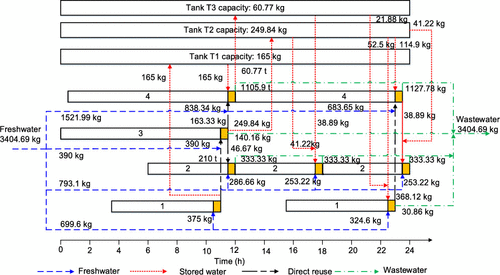当前位置:
X-MOL 学术
›
Ind. Eng. Chem. Res.
›
论文详情
Our official English website, www.x-mol.net, welcomes your feedback! (Note: you will need to create a separate account there.)
Synthesis of Flexible Batch Water Networks Using Dynamic Programming
Industrial & Engineering Chemistry Research ( IF 4.2 ) Pub Date : 2020-06-26 , DOI: 10.1021/acs.iecr.0c01648 Zhiwei Li 1 , Thokozani Majozi 1
Industrial & Engineering Chemistry Research ( IF 4.2 ) Pub Date : 2020-06-26 , DOI: 10.1021/acs.iecr.0c01648 Zhiwei Li 1 , Thokozani Majozi 1
Affiliation

|
Water conservation is becoming increasingly important due to increasing demand and stringent environmental legislations. This work proposes a dynamic programming (DP) method for the design of water-using networks in flexible batch plants. The proposed methodology is described as follows. First, based on the inlet concentration of each operation, all of the operations could be assigned to the specific stages. Second, the water requirement of water-using units in each stage is satisfied by either freshwater or reusable water from other operations, with no option for dilution. The state of stored water is then determined. The target of freshwater consumption is thus obtained after water requirements of all of the operations have been determined. Three examples from the literature are considered. Example 1 is treated as a fixed-quantity problem. Example 2 is a hybrid batch water system comprising fixed-mass load and fixed-quantity operations. Example 3 refers to a water system with multiple contaminants. The results obtained in this work are comparable to those obtained from the published literature, implying that the proposed approach is applicable to redesigning the schedule of water operations in batch plants.
中文翻译:

基于动态规划的柔性间歇供水管网综合
由于需求增加和严格的环境法规,节水变得越来越重要。这项工作提出了一种动态规划(DP)方法,用于设计柔性批处理厂的用水网络。所提出的方法描述如下。首先,根据每个操作的入口浓度,可以将所有操作分配给特定阶段。其次,每个阶段的用水单位的用水量都可以通过淡水或其他操作的可重复使用的水来满足,没有稀释的选择。然后确定储存的水的状态。因此,在确定所有操作的用水量后,即可确定淡水消耗量的目标。考虑了文献中的三个例子。示例1被视为固定数量的问题。示例2是一种混合批处理水系统,包括固定质量负载和固定数量操作。实施例3涉及具有多种污染物的水系统。在这项工作中获得的结果与从已发表的文献中获得的结果相当,这意味着所提出的方法适用于重新设计间歇式工厂的水处理时间表。
更新日期:2020-07-22
中文翻译:

基于动态规划的柔性间歇供水管网综合
由于需求增加和严格的环境法规,节水变得越来越重要。这项工作提出了一种动态规划(DP)方法,用于设计柔性批处理厂的用水网络。所提出的方法描述如下。首先,根据每个操作的入口浓度,可以将所有操作分配给特定阶段。其次,每个阶段的用水单位的用水量都可以通过淡水或其他操作的可重复使用的水来满足,没有稀释的选择。然后确定储存的水的状态。因此,在确定所有操作的用水量后,即可确定淡水消耗量的目标。考虑了文献中的三个例子。示例1被视为固定数量的问题。示例2是一种混合批处理水系统,包括固定质量负载和固定数量操作。实施例3涉及具有多种污染物的水系统。在这项工作中获得的结果与从已发表的文献中获得的结果相当,这意味着所提出的方法适用于重新设计间歇式工厂的水处理时间表。


























 京公网安备 11010802027423号
京公网安备 11010802027423号